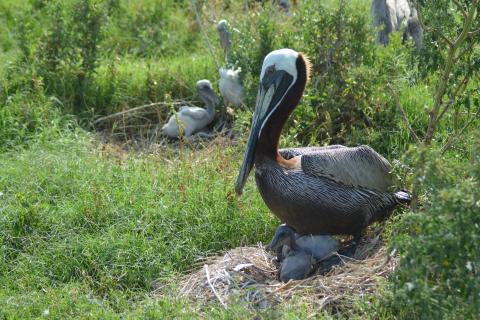The Deepwater Horizon Louisiana Trustee Implementation Group has approved seven new Monitoring and Adaptive Management Activities Implementation Plans (MAIPs).
Of the seven, five of the MAIPs will center on data collection. All of the activities address needs that were identified in the Louisiana Trustees’ Monitoring and Adaptive Monitoring (MAM) Strategy, published in 2021. The goal of monitoring and adaptive management is to maximize benefits to the natural resources targeted for restoration, and report on the outcomes of restoration actions.
The budget for the seven activities totals $36.5 million over the next three to six years, depending on the activity duration.
The seven new activities include:
Coastwide Louisiana Colonial Waterbird Aerial Nest Photographic Surveys (PDF, 24 pages.) The information gathered by this activity will facilitate Trustees’ ability to evaluate restoration effectiveness, address potential uncertainties related to restoration planning and implementation, and provide feedback to inform future colonial waterbird restoration decisions.
Documenting Sea Turtle Nesting in Louisiana (PDF, 13 pages.) This activity will compile and collect data about sea turtle nesting and habitat in Louisiana with the goal of enhancing sea turtle hatchling productivity, and restoring and conserving beach nesting habitat.
Louisiana Coastwide Reference Monitoring System (PDF, 43 pages.) The objective of this activity is to maintain the continuity of the Louisiana Coastwide Reference Monitoring System (CRMS). These datasets are fundamental to Louisiana coastal restoration planning, implementation, monitoring, and adaptive management.
Louisiana Data Management Interoperability (PDF, 22 pages.) This activity will facilitate communications between major restoration databases: The Louisiana Coastal Protection and Restoration Authority's (CPRA) Coastal Information Management System (CIMS) and NOAA’s two applications, the Data Integration Visualization Exploration and Reporting (DIVER) Explorer and the Environmental Response Management Application (ERMA) platform. The goal of this project is to provide greater accessibility for the scientific community, stakeholders, and other interested groups.
Louisiana Fisheries Independent Monitoring Program (PDF, 79 pages.) This activity will provide valuable data for the nearshore habitats and resources targeted for restoration, including coastal wetlands, oysters, nekton (free-swimming organisms), and prey Trustees can use the data to assess changes in the natural resources and their habitats time.
Lower Trophic Level Baseline to Support Restoration of Living Resources in the Barataria Estuary (PDF, 121 pages.) This activity will conduct an inventory sampling and an analysis of key “lower trophic level” organisms. These include phytoplankton, microphytobenthos, zooplankton, and macroinfauna, which serve as the basis of the food web for many recreationally and commercially important fisheries species.
Quantifying Restoration Impacts on Wetland Ecosystem Health and Carbon Export (PDF, 24 pages.) This project will provide a decision support tool for assessing the impact of various restoration types and approaches on coastal wetland ecosystem health, as indicated by net ecosystem carbon balance. This will allow Trustees to visualize where the oil spill and restoration activities influence ecosystem health.
We also send updates out via email. If you haven't already, please take the opportunity to sign up for e-mail updates today to receive the latest news from all the Deepwater Horizon Trustees.


